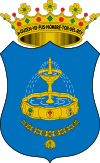Pilas, Spain facts for kids
Quick facts for kids
Pilas
|
|||
|---|---|---|---|
|
|||
| Country | |||
| Autonomous Community | |||
| Province | |||
| Comarca | Sevilla | ||
| Population
(2018)
|
|||
| • Total | 13,949 | ||
| Time zone | UTC+1 (CET) | ||
| • Summer (DST) | UTC+2 (CEST) | ||
Pilas is a town located in the province of Seville, Spain. It's in the western part of Andalusia, a region in southern Spain. Because of where it is, Pilas is close to other interesting places. You can easily visit nearby villages like El Rocío or enjoy the beaches of Matalascañas.
The first people known to live here were from the Celtiberian period, a very long time ago. When the Romans ruled, Pilas was part of the area controlled by Seville. During the time of Al-Andalus (when Muslims ruled parts of Spain), the town was called Pilias. It started to grow around a special building called a "Qubba," which you can still see today. There were also small Muslim farms nearby. The town we know today grew from tile factories located near the Alcarayón stream.
After the Christians took back the land in the late 1200s, King Alfonso X named the town Torre del Rey. Pilas became more important in the 1400s. It was known for its livestock (farm animals). King Juan II of Castile even gave the town special grazing fields in a nearby area called Aznalcázar. Pilas was on a main road, so drinking troughs, called pilas, were built for the animals. This is how the town got its name!
In the early 1900s, more factories and businesses started in Pilas. This helped the town's economy grow and become more successful.
Where is Pilas? Its Geography
Pilas shares its borders with several other towns. To the north, it borders Huévar and Chucena. To the south, you'll find Villamanrique de la Condesa. Aznalcázar is to the east, and Hinojos (which is in Huelva province) is to the west.
The Land and Hills
The land in Pilas is mostly flat, but it does have some gentle hills. The highest points are in the northern areas. These include places like Perú and de la Robaína, which are about 137 and 113 meters (450 and 370 feet) above sea level.
The ground is mostly made up of yellow, muddy, clay-like sands. You'll also find different kinds of limestone and hard sandstones. The area around the Alcarayón river has newer sediments like gravel, sand, and silt.
The main part of Pilas sits on a hillside that slopes towards the east. It's about 50 to 80 meters (164 to 262 feet) above sea level. A small stream to the southeast flows into the Alcarayón river. This river helps drain water towards the nearby marshland.
Besides the river, some areas of land are not good for farming because of natural cuts in the ground. However, these spots are great for nature! They have many different kinds of plants and animals. Two special places, Damiana and la Robaína, are known for their beautiful views and diverse plant life.
Towards the south, the land becomes lower, with marshland and gentle slopes. This is where Pilas reaches its lowest points, about 35 meters (115 feet) above sea level.
Other interesting features are the barreros. These are old quarries where muddy clay was dug out. Even though they are not used anymore, this clay was once very important for making bricks, tiles, and pottery.
The most common crop grown in Pilas is the olive, especially a type called manzanilla. Farmers also grow cereals, fruit trees, and grapevines, though not as much as olives.
See also
 In Spanish: Pilas para niños
In Spanish: Pilas para niños




